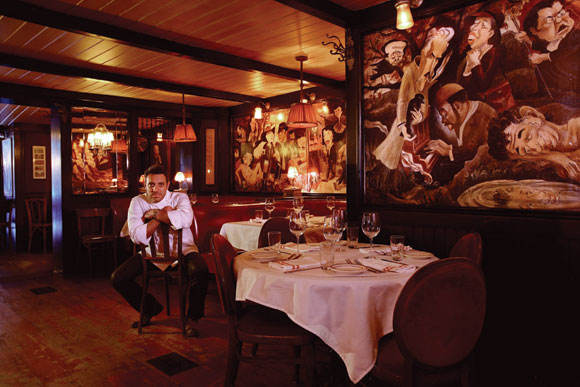alumni profile
A Place at the Table
John DeLucie / GAL ’89
by Christian DeBenedetti

The Waverly Inn is the kind of place that doesn’t list its phone number because it doesn’t need to. A place that counts models, moguls, and movie stars as regulars. A place where even the mac and cheese costs $95 because it’s flavored with white truffles flown in from Alba, Italy. To those who want to get in, it can seem impenetrable. To those who do get in, it’s the modern epitome of “see and be seen.”
Back in the early 1990s, when John DeLucie was stuck in a cubicle at a Midtown employment agency, he had no idea that he’d someday be the executive chef and co-owner of such an establishment. His humble past is still evident on the menu, where patrons will find dressed-up comfort food—a simple yet stylish alternative to haute cuisine. And unlike chefs at some exclusive restaurants, DeLucie, who recently launched his second Village venture, The Lion, warmly greets guests as though they’re family coming over to dinner.
In his recent memoir, The Hunger: A Story of Food, Desire, and Ambition (Ecco), DeLucie offers readers an intimate look inside one of the hottest restaurants to hit New York in decades and tells the tale of his unlikely rise to culinary fame.
Cooking had actually never been part of DeLucie’s plan. Until he moved to Commack, Long Island, at age 5, he lived in then-working-class Carroll Gardens, where his father was a wedding band musician and his mother an office assistant. After college, he was again living in Brooklyn, laboring as a headhunter in the insurance industry—a job he hated. “I’d grown up wanting to be a fireman, a jazz musician, and here I was,” he says. Soon after deciding “I can’t do this gig one more day,” DeLucie, who’d been practicing his mother’s Italian recipes, realized his calling one night when he absent-mindedly whipped up some spaghetti for a group of friends. “I loved the vibe of making people happy,” he writes. “It was like my father playing them a song.”
DeLucie enrolled in a 12-week culinary class at the New School and, upon finishing, walked into Dean & DeLuca to ask for a job. The next day he found himself there chopping 40 pounds of onions. With that experience on his résumé, it wasn’t long before he landed his first restaurant gig at Yellowfingers, an Italian café across from Bloomingdale’s on the Upper East Side. And for the next 15 years, DeLucie, like many New York chefs, careened through several more restaurants until the fateful day that he and two business partners, along with Vanity Fair editor Graydon Carter, inked a deal to buy a faded Greenwich Village restaurant known as Ye Olde Waverly Inn. It was a venture in which, he admits, “[I was] hardly able to believe that somehow I was involved.”
The restaurant opened to packed houses in 2006 and soon DeLucie was cooking for the likes of feared New York Times critic Frank Bruni, who praised the fare, which focuses on simple classics such as roast chicken, pork chops, and old-timey cocktails. While DeLucie ran the kitchen, Carter brought in throngs of writers, celebrities, and tycoons happy to bask in the buzz. “If they graced the cover of Vanity Fair, more than likely they graced the red leather banquettes of our dining room,” DeLucie writes. Take a recent Thursday night: By 6:30, the front room had swelled with walk-ins hoping to score a glimpse of someone famous. Soon rapper Adam Yauch of the Beastie Boys arrived, cutting a low profile. By 8:30, Condé Nast publishing titan S.I. Newhouse, GQ publisher Tom Florio, and author Malcolm Gladwell had filed in (separately) as well. “It’s industry night,” DeLucie cracked.
Some critics have tisk-tisked DeLucie’s dishes for being ordinary and overpriced; others disapprove of the Waverly Inn’s meticulously cultivated exclusivity. But DeLucie shrugs it off. “We are certainly not on the edge of culinary innovation. But that’s the point,” he told the New York Daily News restaurant critic. “You come here to eat well and have a great time, not be challenged.” For now, the real challenge is getting a table deep inside the restaurant’s cozy inner sanctum—which is the kind of challenge that New Yorkers seem hard-wired to take on.







